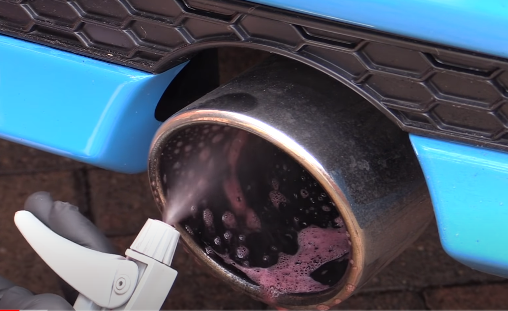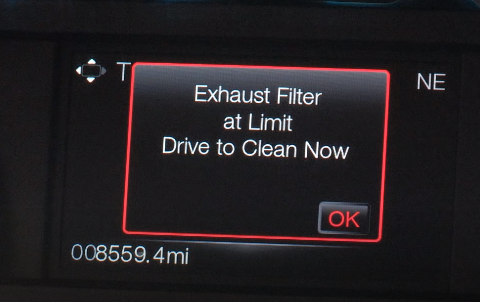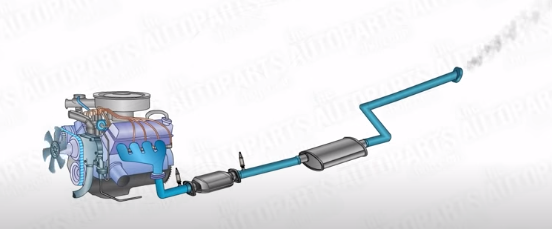If you see a dash lamp on your diesel-powered Ford Transit that reads “Exhaust overloaded, Drive To Clean” or “Exhaust At Limit, Drive To Clean Now,” it is essential that You drive Your vehicle quickly. The capacity of your Diesel Particulate Filter is 100%. You should immediately get behind the wheel and clean your exhaust filter when this happens. The computer will initiate an active regen by feeding the DPF to ignite the remaining soot at temperatures between 950 and 1050 degrees Fahrenheit. Use active regen for maximum effect if you drive between 30 and 35 mph (but not more than 55 to 65 mph) for at least 15 to 30 minutes.
Drive to Clean Exhaust System or Drive to Clean Exhaust Filter will appear on your dashboard. It will inform you that your DPF has become blocked, and you need to clean it soon.
How Does It Work?
This message may be displayed when Duramax needs DPF cleaning. On the other hand, Chevrolet may have something different like “Cleaning Exhaust Filter Keep Driving.” Every diesel vehicle on the road has a Diesel Particulate Filter (or DPF) due to increasing EPA regulations.
The DPF, located in line with the exhaust pipe, converts the soot from your engine into ash and captures it by a filter.
What is The Drive to Clean Exhaust System?

Filter residue accumulates needs cleaning in a process known as regeneration. Usually, DPF filter cleaning if the driver maintains adequate speeds on the highway, the automatic transmission will occur.
Regeneration occurs between 100 and 500 miles. Many things can prevent regeneration and thus cause the clean exhaust message. These are some of the problems that may prevent resurgence:
- Short driving distances.
- Remote control to turn the engine on or off.
- Aftermarket air filters, cold air kits, and airboxes are available.
What to Do When You Get the Drive to Clean Exhaust System Message?

Regeneration is the process of cleaning your DPF. Typically, the Drive to Clean Exhaust System message or Drive to Clean Exhaust Filter message should appear. After a while, it should go away and change to Cleaning Exhaust Filter. DPF is full-time continue driving
There are many types of regeneration, and which one you choose will depend on certain factors.
- If you get the Cleaning Exhaust Filter message quickly, Use Passive Regeneration.
- If you’ve been driving a lot around town, Use Active Regeneration.
- You have driven short distances: Use Active Regeneration.
- Use Active Regeneration if you’ve been driving a lot.
You may see the following message while driving on the highway. Use the Parked Regeneration
The type of regeneration you choose will depend on several factors. Let’s now discuss each kind of regeneration.
Passive Regeneration
Passive regeneration, or passive cleaning of DPF filters, uses average exhaust temperatures and nitrogen oxide as catalysts. This regeneration mode is automatic, straightforward, and removes soot trapped as the vehicle runs. Also, DPF cleaning happens during everyday driving.
If the warning messages are not displayed, the driver may continue to drive as standard. Continue driving with the DPF filter on full.
Active Regeneration
Active regeneration is most common in long-haul or high-speed driving, especially on highways. If everyday driving and passive regeneration fail to clean the DPF adequately, pressure sensors will detect excessive soot.
The warning message prompts the driver to drive at a 17-30 mph speed for approximately 20 minutes to activate regeneration. The engine control module tells the system that active regeneration cleans the filter, eliminates pollutants, and increases exhaust temperatures.
Active regeneration is when raw fuel is injected into a diesel oxidation catalyst system (DOC) to remove soot from the DPF.
For either of these regeneration processes, drivers need not intervene.
Parked and Operator Command Regeneration
A driver must use parked regeneration or operator command regeneration if the vehicle cannot maintain speed for active or passive regeneration to allow the operator to start revival even if the car is not in use. Operators must have a 100% load on the particulate filter to make this work.
These are the steps for completing parked regeneration:
- Turn the engine on and get it up to temperature.
- Follow the prompts and press the information display button.
- Answer “Yes” to begin the process and exhaust positioning.
- After an operator regeneration has begun, the engine revs to 2000 rpm.
- The engine and cooling fan will be back to normal after completing the regeneration process. The exhaust system will heat up and take approximately 30 minutes to complete the regeneration.
This guide opens how to park a Freightliner is for Freightliner drivers.
Although each regeneration method is different, they all work on the same principle, emitting diesel particulates at 600 degrees Celsius or higher. Active systems onboard use more fuel or additional power to the DPF’s electric structure to complete the burn-off.
Regeneration refers to removing accumulated soot or ash from the DPF filter. Each diesel builder will have different methods or display messages to guide them through this process. The fundamental goal is the same. Each regeneration cycle lasts between 9 and 20 minutes.
Other important DPF Warning Messages
Modern warning system technology has reached an unimaginable level. Digital vehicles today are equipped with hundreds of sensors that communicate every condition and make repairs much more accessible.
Service technicians can diagnose problems faster and with more certainty. Operators should pay close attention to DPF messages.
Don’t let your exhaust filter get too full.
Limit Drive to Clean Now
You could be charged with a DPF violation if you ignore the warning message. “Exhaust filter over the limit, service now” is an example of a message you might see if you ignore the warning signs.
This message will cause a reduction in torque of 20%-30% for the operator. A certified technician must clean the filter to disable the regeneration.
Additional messages about DPF cleaning
Clean Now, Exhaust Filter at the Limit
If your exhaust system is overheated, stop now.
Exhaust Filter Drive Complete
What is The Reason for Emission Errors?

Manufacturers of diesel engines have worked hard to create cleaner engines without producing too many toxic substances.
This results in powerful internal combustion engines that are highly reliable, have exceptional fuel mileage, excellent torque, and are highly reliable for use in small passenger cars or huge earthmovers.
Engineers continue to work on improving diesel exhaust emissions. The first developed Diesel engines were in the 1930s, and in their early years, they filled tailpipes with soot, carbon, nitrous oxide, and other harmful particulates.
Engineers have developed two major emission technologies to address these problems.
- DEF negates the harmful effects of nitrous oxide.
- Diesel particulate filters (DPF) reduce soot, carbon-based pollutants, and ash.
Drive to Clean Exhaust System (or any other error that could lead to emissions problems) is one example of how you can help yourself.
Diesel Particulate Filters and Diesel Exhaust Fuel
Modern diesel engines have two primary pollutant control mechanisms: diesel exhaust fuel (DEF) and Diesel particulate filters (DPF).
A DPF can remove up to 100% of particulate matter from diesel exhaust under certain conditions. Otherwise, the DPF won’t function properly.
Diesel soot results from incomplete combustion of diesel fuel. Depending on the type of engine, fuel used, and size of the vehicle, carbon and other particulates can vary.
Many filter technologies are currently in use:
Cordierite is the most popular material. Ceramic-based cordierite is inexpensive and efficient in filtering.
Silicon carbide is second in popularity as a filtering material. Silicon carbide is more efficient than silicon carbide in thermal efficiency but has a lower melting point.
DPF filters are the most cost-effective way to capture and dispose of diesel particulate matter.
Regeneration techniques can prolong the life expectancy of filters by “burning away” soot and other carbon particles. Thermal regeneration is the most efficient and complete way to operate particulate filters.
The Key Takeaways
Emission regulations are becoming more difficult due to the continued development of DPF/DEF systems. There were no standards for controlling what was coming out of the tailpipe in the 1960s. Americans could easily see the effects of diesel fuel by the black smoke coming out of their exhaust pipes.
The EPA has reversed the trend by reinforcing the regulations that came into effect in 2010. Modern diesel engines are proficient and pristine. The 2010 EPA regulations on diesel engines were the most critical clean-air regulation we have ever seen. The standards can reduce carbon and nitrogen oxide emissions by 1,000,000 tons annually, similar to removing millions of vehicles from the highway. Clean exhaust systems are critical controls that help us get the job done.
